A) Baking ovens
B) Interest on business loans
C) Annual lease payment for use of the building
D) Baking supplies (flour,salt,etc. )
Correct Answer

verified
Correct Answer
verified
Multiple Choice
Total fixed cost (TFC) :
A) falls as the firm expands output from zero,but eventually rises.
B) falls continuously as total output expands.
C) varies directly with total output.
D) does not change as total output increases or decreases.
Correct Answer

verified
Correct Answer
verified
Multiple Choice
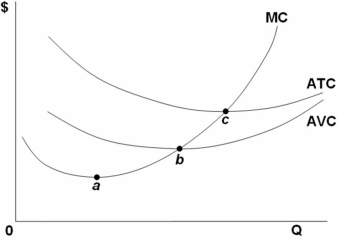 Refer to the above diagram.This firm's average fixed costs are:
Refer to the above diagram.This firm's average fixed costs are:
A) not shown.
B) the vertical distance between AVC and MC.
C) the vertical distance between AVC and ATC.
D) equal to the per unit change in MC.
Correct Answer

verified
Correct Answer
verified
Multiple Choice
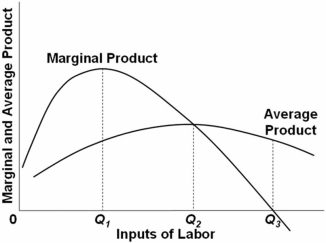 In the above diagram,total product will be at a maximum at:
In the above diagram,total product will be at a maximum at:
A) Q3 units of labor.
B) Q2 units of labor.
C) Q1 units of labor.
D) some point that cannot be determined with the above information.
Correct Answer

verified
Correct Answer
verified
Multiple Choice
 The above diagram shows the short-run average total cost curves for five different plant sizes of a firm.The position of these five curves in relation to one another reflects:
The above diagram shows the short-run average total cost curves for five different plant sizes of a firm.The position of these five curves in relation to one another reflects:
A) economies and diseconomies of scale.
B) the effect of fixed costs on ATC as output increases.
C) the law of constant costs.
D) the law of diminishing returns.
Correct Answer

verified
Correct Answer
verified
Multiple Choice
The most effective form of business organization for raising money to finance the expansion of its facilities and capabilities is a:
A) partnership.
B) corporation.
C) conglomerate.
D) sole proprietorship.
Correct Answer

verified
Correct Answer
verified
Multiple Choice
The principal-agent problem in corporations arises from:
A) the fact that the principal objective of most corporations is to make profits and not to contribute to charity.
B) a conflict of interest between corporate executives who manage the firm and stockholders who own the firm.
C) the view that workers are agents who are not considered to be the principal asset of the corporations for which they work.
D) a perspective that corporations are agents that represent the principal source of power for government and the national economy.
Correct Answer

verified
Correct Answer
verified
Multiple Choice
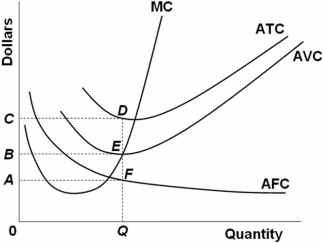 Refer to the above diagram.At output level Q total fixed cost is:
Refer to the above diagram.At output level Q total fixed cost is:
A) 0BEQ.
B) BCDE.
C) 0BEQ - 0AFQ.
D) 0CDQ.
Correct Answer

verified
Correct Answer
verified
Multiple Choice
The law of diminishing returns describes the:
A) relationship between total costs and total revenues.
B) profit-maximizing position of a firm.
C) relationship between resource inputs and product outputs in the short run.
D) positive relationship between resource inputs and product outputs in the long run.
Correct Answer

verified
Correct Answer
verified
Multiple Choice
A group of three plants that is owned and operated by a single firm and that consists of a farm growing wheat,a flour-milling plant,and a plant that bakes and sells bread would best be an example of a:
A) multiplant firm.
B) vertically integrated firm.
C) partnership.
D) conglomerate.
Correct Answer

verified
Correct Answer
verified
Multiple Choice
 Refer to the above information.Average total cost is:
Refer to the above information.Average total cost is:
A) ![]() .
.
B) ![]() .
.
C) ![]() .
.
D) ![]() .
.
Correct Answer

verified
Correct Answer
verified
Multiple Choice
The total output of a firm will be at a maximum where:
A) MP is at a maximum.
B) AP is at a minimum.
C) MP is zero.
D) AP is at a maximum.
Correct Answer

verified
Correct Answer
verified
True/False
In economics,a firm earns a normal profit when its total revenue equals its total economic costs.
Correct Answer

verified
Correct Answer
verified
Multiple Choice
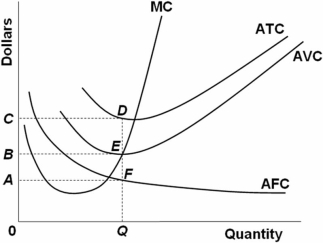 Refer to the above diagram.At output level Q total cost is:
Refer to the above diagram.At output level Q total cost is:
A) 0BEQ.
B) BCDE.
C) 0BEQ plus BCDE.
D) 0AFQ plus BCDE.
Correct Answer

verified
Correct Answer
verified
True/False
The real opportunity cost of producing product X is the amounts of products Y,Z,and so forth,that might have been produced if resources had not been used to produce X.
Correct Answer

verified
Correct Answer
verified
Multiple Choice
If a firm decides to produce no output in the short run,its costs will be:
A) its marginal costs.
B) its fixed plus its variable costs.
C) its fixed costs.
D) zero.
Correct Answer

verified
Correct Answer
verified
Multiple Choice
Which of the following definitions is correct?
A) Accounting profit + Economic profit = Normal profit.
B) Economic profit - Accounting profit = Explicit costs.
C) Economic profit = Accounting profit - Implicit costs.
D) Economic profit - Implicit costs = Accounting profits.
Correct Answer

verified
Correct Answer
verified
Multiple Choice
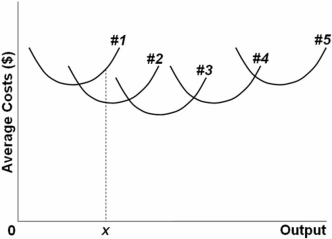 The above diagram shows the short-run average total cost curves for five different plant sizes of a firm.In the long run the firm should produce output 0x with a plant of size:
The above diagram shows the short-run average total cost curves for five different plant sizes of a firm.In the long run the firm should produce output 0x with a plant of size:
A) #4.
B) #3.
C) #2.
D) #1.
Correct Answer

verified
Correct Answer
verified
True/False
Average fixed costs diminish continuously as output increases.
Correct Answer

verified
Correct Answer
verified
Multiple Choice
Which of the following is most likely to be a fixed cost?
A) Shipping charges
B) Property insurance premiums
C) Wages for unskilled labor
D) Expenditures for raw materials
Correct Answer

verified
Correct Answer
verified
Showing 81 - 100 of 156
Related Exams